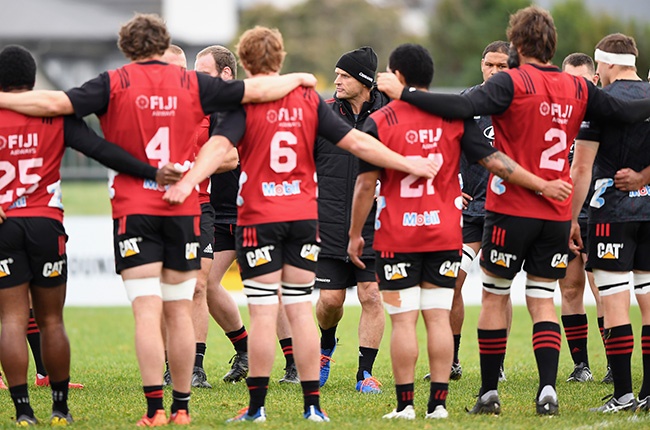


Head coach Scott Robertson speaks to his players during a Crusaders Super Rugby training session at Rugby Park on 3 June 2020 in Christchurch, New Zealand. (Photo by Kai Schwoerer/Getty Images)
- While it remains moot as long as government delays its approval, South African rugby has the added headache to pondering whether the players will have enough contact training for a return to play.
- Given local professional players’ relatively severe level of inactivity over the past four months, the assumption would be an extended pre-season is needed.
- Yet Louis Janse van Rensburg, the Pumas’ fitness guru, surprisingly says that SA players might merely need a month of contact training to be ready for competitive action in this special Covid-19 context.
- There is, however, no real correct answer for what constitutes a proper conditioning period.
As local rugby anxiously awaits government’s green light for a return to training, the issue of proper, holistic preparation for any sort of competitive play steadily moves squarely into the spotlight.
With each passing day, the possibility of fitting a tournament into a shrinking calendar becomes smaller and the need to fast-track conditioning bigger.
Given local professional players’ relatively severe level of inactivity over the past four months, the assumption would be an extended pre-season would be required in order to at least minimise so-called avoidable injuries such as soft tissue problems.
Yet how much contact training is required for a player to be ready to play again, at least in the current Covid-19 context?
The answer is rather surprising.
“Interestingly, our planning and SA Rugby’s overall protocols allow for a pretty short turnaround time,” Louis Janse van Rensburg, strength and conditioning coach of the Pumas, told Sport24.
“The players would only need about three to four weeks of contact training to be in decent shape to play competitively again. Of course, that’s also dependent on a player having effective non-contact training as well for about a month before that.”
If such a period sounds a bit hair-raising in terms of how short it is, it’s not unprecedented.
New Zealand’s franchise only commenced with training again on 18 May for a 13 June start of Super Rugby Aotearoa, though it must be taken into account that the country’s lockdown was short and the players weren’t prohibited from doing outdoor exercise for an extended period like their South African counterparts.
Nonetheless, approximately eight weeks seems to be the magic number for a return to play.
However, Janse van Rensburg – rather importantly – notes that there will never be a correct answer for what constitutes a proper conditioning period.
“Ideally, any conditioning coach would tell you that he or she would want a long, extended pre-season with the players. But you could also argue that the post-World Cup period was maybe a bit too long for some teams,” he said.
“The thing is, each player’s body is different and each of them would actually require a programme tailored for them. Yet we all know that the calendar doesn’t allow for that.
“So it’s really just about developing a plan with what’s in front of you and doing your best to make things work. But don’t be surprised if we can get back to playing relatively soon.”

